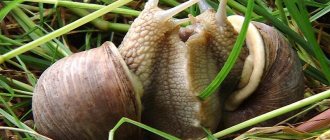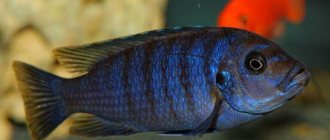The Achatina snail is one of the most famous and common pets, which has gained popularity due to its impressive size, easy care and exoticism. Despite the fact that every year there are more and more recommendations regarding keeping Achatina at home, many people have questions about how long Achatina snails live at home. Before you find out the life expectancy of these charming creatures, you should know that these numbers are influenced by many factors that the owner of the mollusk must be aware of.
Description of the Achatina snail
Africa is the homeland of these interesting animals. But at the end of the 19th century. Achatina also settled in other tropical countries. In nature, they live in large colonies. Achatina is a gastropod of gigantic size. It has a shell, a head with visual organs located on the so-called antennae, and a body called a “leg.” The color of the body and shell varies from yellow to brown.
In nature, snails of the Achatina species live how long it is not possible to find out, but it’s clear that they don’t live long. They have enough enemies. You can say a special “thank you” to a person for his short life. But the snails themselves ruined their reputation: these mollusks are too voracious. They are considered pests: in addition to destroying people's landscaping, they happily gnaw away the plaster from the walls of houses, which they need to build a sink. At home, Achatina can reach very impressive sizes: from 15 to 27 cm in length and weight up to 500 g.
Achatina is very slow. In 1 minute they can cover no more than 1 cm. But they have an excellent memory. True, it only lasts an hour, but this time is enough to return to the bowl of food. As for communication with a person, the snail not only remembers its owner, but also recognizes it. If desired, Achatina can develop certain reflexes, and a trained snail is a reason to be proud.
Lifespan
These original gastropods serve as a striking example of the fact that mollusks can live longer in captivity than in the wild. Naturally, only if the owner provides them with suitable conditions and takes into account all the characteristics of these inhabitants.
The minimum life cycle of domestic snails is 5 years, but many individuals quietly live up to their 10th anniversary. As a rule, the better the owner takes care of Achatina, the longer she will live.
But wild snails are not so lucky; in the natural environment there are too many people who want to feast on these large mollusks. In some countries, they are real pests, capable of destroying entire crop plantations. Here they are actively engaged in their extermination; their breeding and sale is prohibited at the legislative level.
House for Achatina
Before purchasing an aquarium for a new family member, you need to decide on the number of future “tenants”. For one pet you need to allocate 10 liters of “aquarium” housing. Accordingly, for 10 snails you will need a 100-liter aquarium. Achatina grows as long as they live. Therefore, if you are “greedy” with the size of your home, you won’t have to wait for full growth and proper development.
The house must have a roof. Otherwise, the “X-hour” will come, when a search operation will unfold throughout the house to capture the fugitive. And you don’t need to rely on your pet’s slowness: snails are nocturnal animals, so there’s plenty of time to “go beyond the horizon.” And this is a dangerous journey: if there are other pets in the house, then the risk of finding only a shell is very high.
It is necessary to use soft, loose soil as a filler. The soil is not suitable for houseplants, there are too many chemicals. But coconut substrate deserves attention. Pebbles or sawdust are prohibited: the snail can be injured, which obviously will not add to its longevity. It is easy to determine whether an animal is satisfied with the soil or not: if the snail literally “climbs the wall,” then it is necessary to change this filler to another. But if Achatina burrows into it with pleasure, then the gastropod is happy with everything. The soil and walls of the aquarium must be sprayed with water every day. Achatina, although a land snail, loves moisture very much. You can diversify the landscape with a small bowl of water. Firstly, this is a drinking bowl. Secondly, the pool: snails love to swim. Just take into account the size of the “lake”: kids can easily drown.
The aquarium must have secluded corners. Snails are active at night and hide during the day. You won’t be able to hide in open space, but instinct demands its own. The life expectancy of a mollusk depends on comfortable living conditions. The temperature in the clam house should be between 25 - 28 degrees. At low or high levels, the snails go into hibernation. To maintain the required amount of heat, it is enough to use an incandescent lamp. It is strictly forbidden to place a snail on a window: direct sunlight is detrimental to mollusks, as well as negative temperatures.
The aquarium itself also needs to be looked after. It is important to maintain cleanliness in the home: promptly remove food debris, clean out excrement, wipe the walls of the aquarium with clean water, without using any cleaning agents or detergents. The filler needs to be changed as it gets dirty, but at least once a year.
Diseases and prevention
If the snail becomes lethargic, refuses to eat, goes inside the shell, or secretes very thick mucus, it means it is sick. Sometimes there is peeling of the shell. Causes of the disease: mechanical damage, including gnawing of shells by other snails, infection by parasites, poisoning or prolapse of internal organs.
The disease can be prevented by proper care and careful monitoring of your pets. Snails should be fed with calcium, choose appropriate food, and maintain hygiene in the terrarium. Apply iodine, potassium permanganate solution, propolis ointment or glue to chips and cracks.
Achatina snail menu
The menu directly affects how many years Achatina snails live. Being in its natural habitat, the snail's diet is very diverse. But providing a complete menu to keep your pet healthy is extremely important.
It must be borne in mind that Achatina is slightly picky in choosing food. It's all about variety and habits. If your pet is fed only a certain food for a long time, then it is unlikely that he will agree to anything else later. And this will directly affect life expectancy. The diet must include:
- Fruits: everything except citrus fruits.
- Berries.
- Vegetables: everything except hot types, such as bell peppers. Cucumbers are a real delicacy for snails.
- Cereals: oatmeal, peas, beans. Of course, in finished form. Peas and beans can be given fresh.
- Mushrooms: fresh and boiled.
- Dairy and fermented milk products.
- Minced meat (in any form), meat flour.
- Bread.
- Nuts: chopped peanuts.
- Plants: dandelions, forget-me-nots, tree leaves. Be sure to rinse thoroughly.
It is forbidden to give Achatina fried, spicy, sweet, sour, salty, smoked.
Diet is very important. It is enough to feed Achatina once a day, in the evening. During these hours, the snails wake up and happily start eating. You cannot leave stale or dried food in the aquarium. Firstly, this is home hygiene. Secondly, the health of the pet, and therefore the number of years of life of the pet, depends on the quality of food. Experienced owners do the following: feed in the evening, clean up the leftovers of dinner in the morning. In this case, the conditions of detention in terms of nutrition and hygiene are observed.
A little philosophy or why it is important to know how long a pet lives
Before getting any pet, I always research:
- living conditions and behavioral characteristics (in order to understand whether I can create these conditions for the pet and whether I can even live with such an animal);
- pet's life expectancy.
The last fact is important for me personally, because I:
- I don’t get animals that live too short (1-3 years).
- I don’t get animals that live too long (30 years and above).
For example, I love pet rats and I had a rat a long time ago when I was in school. But I don't want to have this pet anymore. And not the last reason for this (although not the only one) is the short life expectancy. Only 2-2.5 years. You become attached to any pet and it is very sad to have an animal for such a short period of time. Sometimes such pets do not live to this age.
Some animals, on the contrary, live too long. For example, turtles. Some of the species kept at home live up to 50 years. At one time I thought about getting a turtle, but for this and some other reasons I abandoned this idea. Passing on a turtle by inheritance or transporting it around the world if it becomes necessary to move (by the way, this is not possible or legal everywhere; with cats it’s easier in this regard) - I’m not ready for this.
I myself know several stories where people released turtles into nature because they were tired of them or because at some point it became inconvenient. This happens not only with turtles (although it happens with turtles very often), unfortunately. But I know one family who rehomed their turtle (with great difficulty, I must say, because the animal was elderly), since it outlived its owner.
Digressing from the topic, I’ll say - think about all the pros and cons before getting any pet. There are no bad pets, there are unprepared owners who, having seen a cute fluffy rabbit or a funny ferret, buy an animal and find out that they were not prepared for certain features of its maintenance, behavior, and lifestyle. Some people throw these animals away, some give them away, some release them into the wild (it’s crazy, but true - turtles are often released into the wild, without thinking that they won’t be able to survive in any climate).
I consider such people simply irresponsible.
What do you think about this? Share your opinions in the comments - I will be very interested.
Conclusions on the basic rules for keeping Achatina
To bring everything to a common denominator, it is necessary to highlight the main recommendations for keeping and breeding Achatina.
- It is necessary to decide how many Achatina snails will live in one aquarium/terrarium. Based on this, you should choose the correct volume of the future home for mollusks.
- For kids, it is better to line the bottom of the aquarium with cabbage or lettuce leaves. This way, young snails will be able to get food at any time. But we must not forget about the diversity of the diet, which determines how long Achatina snails live at home, as well as their eating habits. In such conditions, the younger generation can live for 3–4 months.
- For adults, it is important to carefully select the soil. It is better to use products that are specially produced for such exotic pets. Even if you choose an alternative cover, you should carefully study its composition. There shouldn't be any chemicals in it.
- Home hygiene. Cleaning should be carried out at least once a month - one and a half. The frequency of soil replacement also depends on how many pets live in one area at the same time. One pet can live for six months on the same lining, but for a larger number of snails, the soil needs to be changed much more often. When mucus appears on the walls of the aquarium, you need to carry out extraordinary cleaning, which will prevent the appearance of an unpleasant odor. You can use baking soda to remove tough stains.
- Maintaining microclimate. Not only the pet’s health, but also how long Achatina lives at home depends on comfortable living conditions. To create comfortable conditions, the walls of the aquarium must be moistened with a spray bottle. It is important to observe the temperature regime. Avoid drafts and direct sunlight. Properly organize the landscape, which must have secluded corners for relaxation. Bring it as close to natural conditions as possible.
Use in cosmetology
Preparations with snail mucus are popular among women. They use these products to treat the skin on the face, chest and hands. Men use snails for massage.
Use of mucin
Snail mucus, called mucin, is rich in protein and is used:
- to moisturize and nourish the skin, reduce wrinkles;
- eliminate various skin problems and relieve inflammation;
- as peeling and for anti-aging procedures;
- to restore damaged tissue.
Keep the mask of mucin and banana for 20 minutes, applying it every other day for a month.
The second recipe is mucin, clay and spring water. After removing the composition, the skin is lubricated with day cream.
Attention! Snail mucus is suitable for all skin types regardless of age. The only warning is a possible reaction to the protein, manifested by mild irritation.
Achatina massage
Such large snails massage the forehead, cheeks and other parts of the body, at the same time moisturize and nourish, secreting beneficial mucus.
Procedure:
- Wash without using detergents.
- Wash the Achatina with warm water and feed it lightly.
- Lubricate the skin with cosmetic milk.
- Lie down and apply the clam.
- After 15 min. The shellfish is removed and the mucus is rubbed in.
- In another 15 minutes. You need to wash your face and use a moisturizer.
Attention! Massage with Achatina snails helps treat cellulite, copes with the “orange peel”, smoothing the skin. 15-minute procedures 2-3 times a week are enough.
Effect of calcium on shellfish
Snails need calcium to build their shells. Calcium is a very common chemical element.
Lack of calcium in the snail's diet leads to curvature and deformation of the shell. The snail shell becomes softer due to lack of calcium; it is not protected from the environment. Since all internal organs are attached to the walls of the shell, any damage to it can lead to improper functioning of the organs or death. A mollusk that does not receive calcium from food, as a rule, lags behind in development: shell growth is disrupted or stops altogether, and puberty fails.
In order to prove how important calcium is for snails, I conducted an experiment.
Two groups of snails of the same age and species were taken and placed in the same conditions, but they were fed differently: some with food with added calcium, others with its complete absence.
Soon the snails of the second group stopped growing. It follows from this that calcium is indispensable for mollusks.
Snails kept in captivity receive calcium from sepia, eggshells, feed chalk, shell rock, gammarus, etc. For a more effective result, calcekashes are made. Calcekasha is a nutritious mixture made from various cereals with the addition of various sources of calcium; This product is served both dry and boiled.
Life threatening
Now let's talk about what you shouldn't feed your pet snail. Salty, fatty, fried, sour and bitter are death for her. Citrus fruits, dairy and pasta products are contraindicated for Achatina.
It is worth excluding raw potatoes from the diet, since snails cannot digest the starch they contain.
You should not feed Achatina with flour products and boiled eggs. Be careful with these products. There is no need to feed the snail your food from the table. Salt in its pure form is poisonous to snails, and even a small part of it can kill your pet.










